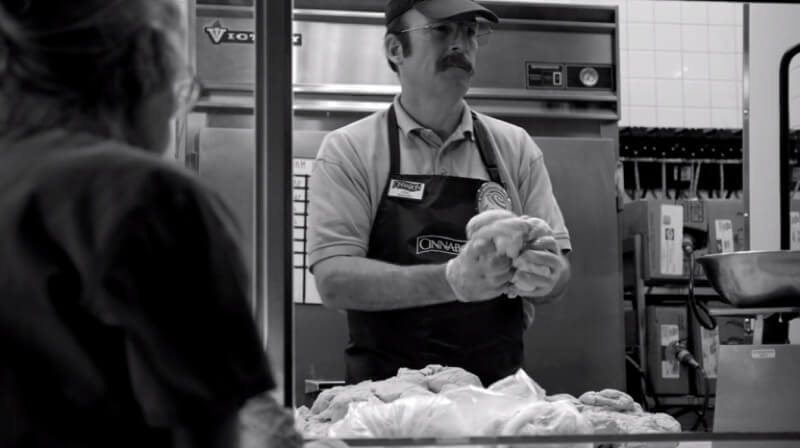Posted on Mar 22, 2017
Netflix & Write: 8 Shows That Will Make You a Better Novelist
Reedsy editor and novelist Andrew Lowe highlights an excellent way to improve your writing craft without the need to read a word or skip a YouTube ad. You’ve probably already absorbed it without even knowing.
I’ll bet you have stacks of writing-advice books stashed away, unopened, on your Kindle, as well as reams of writing-advice features bookmarked in your browser or read-later apps. While you should absolutely adopt a learning mindset when it comes to becoming a better novelist, don’t forget that you can immerse yourself in a fine source of writing advice that’s probably already sitting right there on your TV, laptop, tablet and phone: streaming TV shows.
Unlike feature films, which have very little time to establish their characters in the minds of viewers, streaming shows need to pace themselves — gradually cranking up the heat, seeding recurring themes, applying subtle shifts and teases. Their job is to introduce — and market — a concept, then grow it over a pre-set period, keeping the consumer compelled and invested.
Like a novel.
So go ahead. Put on your 'critical thinking hat,' and catch up on eight shows that will teach you pretty much everything you need to know about characters, pacing, thematic development, and more! (Warning: major spoilers ahead!)
On starting a story — Better Call Saul

Thriller writers will be aware of the need to start a story with a bang: a Bond movie-style pre-credits action sequence, or an intense prologue that serves as an entry point to spike a reader’s attention before getting down to the initial, usually more sedate, stirrings of the narrative. Better Call Saul is even bolder.
The opening sequence of Series One shows a monochrome flash-forward with the character Breaking Bad fans recognize as sleazy-smart lawyer Saul Goodman, toiling in a branch of Cinnabon. His hair has thinned, and he seems limp and downtrodden as he prepares the gloopy mixture and locks up to head home for an evening with Mr. Jack Daniels. After the credits roll, we zoom back to the pre-glory days, with the nascent ‘Saul’ — Jimmy McGill — working his way up from the mailroom at an eminent law firm.
Showrunner Vince Gilligan poses a powerful question: how does it all go wrong? Since the show is a spin-off, and most viewers will be aware of the character’s eventual association with high-powered drug cartels, we’re being told to strap in for a serious fall-from-grace story. (Which can be just as compelling as a rise-to-power.)
In your writing, there are multiple techniques to grab a reader’s attention from the first page. Better Call Saul is a great example — particularly for series writers with characters who are already established — of how you can present a future ‘spoiler’ as a twisted sort of punchline, and then construct your story around the telling of the joke.
Where to watch? Netflix
On how to build suspense — The OA

A former tutor once gave me a great tip that applies to writing: don’t give away all your sweets at the start.
You need to engage your reader and get things moving early on, but if you reveal too much, too soon, you will struggle to maintain interest. Leave room to bring in side-themes, callbacks, reveals, reinforcements. You need to create a sense that more will be revealed and that it’s worth waiting for.
In The OA, the writers open the story with the sudden reappearance of an adopted young woman, Prairie, who has been missing for seven years. Though her blindness appears to have been cured, she has strange scars on her back, and she insists on calling herself “The OA”.
The show takes two hour-long episodes to examine Prairie’s family and her local connections. It then reveals how a near-death experience as a child led to her being captured and studied by an obsessive recluse bent on discovering the secret to immortality.
Those two hours are crucial in building the culture of the show and drawing the viewer into Prairie’s story. We begin the third hour almost overloaded with questions. Is she telling the truth? Why has she returned now? What has happened to the recluse’s other subjects? How did she get away? And, of course, is all of this true or is she just crazy?
Resist the urge to offer up too many answers in the initial part of your narrative. Mystery, wanting to know what happens next, second-guessing based on little teases and detail… It’s what keeps the reader turning the pages. Don’t worry about ‘losing’ them by not giving enough away. If you seed your early intrigue with care and craft, the reader will stay with you. It’s more powerful to place a question in their mind than it is to gratify them with an answer. Hold on to those sweets.
Where to watch? Netflix
On creating interesting, relatable characters — Fargo

We all know that classic cardinal rule of storytelling: make me care. But there’s a myth that readers have to “like” a character in order to be engaged in what happens to them. All you really need to do is to make the character real, authentic, believable, human; someone who looks, talks and acts like a relatable person; someone with all-too-typical human doubts, frailties, impulses; someone who doesn’t always make the “right” decision and is often forced to improvise. If you can get that right, then your reader will root for the character and be engaged with your story, because they will recognize little bits of themselves.
The underdog is a timeless character concept because all the readers not born into a life of easy privilege (i.e. most of them) will feel an instant personal connection to a story of survival against the odds.
In the second series of Fargo, beautician Peggy and her butcher husband Ed try to cover up their hit-and-run killing of a crime family’s youngest son. The writers portray Peggy and Ed as an average blue-collar couple swept into a vortex of gang warfare and in-fighting. They’re (relative) innocents who are bullied and hunted and brutalized, and when their fight-back finally comes, it’s loaded with righteous rage that will have every viewer cheering them on.
When you’re planning a piece of writing, pay close attention to your characters’ journeys (economic, social, emotional, romantic). Generally, the further the character has to travel, the more powerful the connection with the reader will be. If you can take a character from the lowest low to the highest high throughout the course of a novel, then you’ll have something almost fable-like in its universal appeal to empathy. (See Rocky, Slumdog Millionaire, even Scarface.) This is also the reason why Die Hard is such a feel-good Christmas classic. (Ordinary guy trying to reconnect with his estranged wife becomes an overnight hero.)
Where to watch? Hulu (US), Netflix (UK)
On character development — Breaking Bad, Designated Survivor, The Girlfriend Experience

We’re all works in progress, being molded and remolded by our choices and experiences. By the time your novel comes to its conclusion, your characters will feel more authentic if they’ve developed or diminished as a result of the story you’ve just told. The transformation can be radical or subtle, but the reader should not leave the characters as they found them.
Maybe they start the novel believing one thing, and the events shift them to the other end of the scale: from obedient automaton to wild-eyed advocate of free-thinking. (In Nineteen Eighty-Four, Winston Smith moves from one end of the scale to the other, and then back again.)
Maybe the story is all about them wanting something and having trouble getting it — and then, when they get it, their outlook has changed so much they’ve realized they don’t want it anymore. (This is what happens in Pixar’s Cars. Lightning McQueen starts the film thinking that life is all about being the fastest, the best. But by the end, he’s realized that slowing down and being connected to friends is more important.)
The effect of character change can be very satisfying — it’s possible to make it the subject of the entire story.
A familiar theme of transformation is often the shift towards more control. In Designated Survivor, Kiefer Sutherland’s Tom Kirkman moves from the powerless post of Secretary of Housing to the all-powerful POTUS. In The Girlfriend Experience, Riley Keough’s Christine transforms from a dead-eyed, bullied legal intern into a formidable high-class escort who, in the extraordinary final episode, becomes the puppet-master of a complex power play.
In Breaking Bad, high-school chemistry teacher Walter White (Bryan Cranston) transforms from nebbishy suburban dad in slacks to his badass alias, ‘Heisenberg’ — a brutal and venal meth kingpin, smiting his enemies with a remote-controlled machine-gun. The writers even found time to build in dialogue telegraphing the Breaking Bad character change, right there in Episode One, when Walter is teaching a class.
“Chemistry is the study of change. It is growth, then decay, then transformation.”
The trick is to manage the change, so it feels plausible and woven into the fabric of the story. Make it slow and subtle and deliberate and, crucially, close to the key theme or through-line. Walter White’s change is satisfying because of the way his morality is eroded by his situation. At the start, he justifies his behavior as something he has to do to provide for his family. But by the end, he freely admits that he did it all because he “liked it,” and the character has done more than just change in behavior and outlook; he has mirrored his academic discipline and alchemized from one state to another.
Where to watch? The Girlfriend Experience: Starz (US), NowTV (UK); Designated Survivor: Hulu (US), Netflix (UK); Breaking Bad: Netflix
On choosing your setting — Bloodline

Think of your novel’s geographical setting as a character, and you’ll realize you can do a lot more than just use the locations as a static backdrop. Incorporate the subtleties of the geography as a direct influence on your characters’ behavior, or as a way for them to achieve their goals, good or bad.
Bloodline explores the murky secrets of a dysfunctional family after they gather for an anniversary celebration at their seaside hotel in the Florida Keys. The idyllic tropical setting is an ideal contrast to the family’s interpersonal fault lines: a blissful natural exterior to offset the corrosive psychological interior. The oppressive heat mirrors the family’s simmering grudges, the isolated location ramps up the tension and enhances the horror of the violence, and of course, the local swamps are ideal metaphors for those hidden motives and long-concealed secrets.
If Bloodline were set in some out-of-town country hotel, in a mild climate and with good connections to nearby civilization, it would still be possible to tell the story, but the storytelling tools would be blunted, and the effect would be half as rich.
Where to watch? Netflix
On finding your theme — Stranger Things
There are two questions non-writers will often ask writers.
- Where do you get your ideas from?
- What’s it about?
(1) varies from writer to writer, but if you can’t answer (2) with something solid and succinct, there’s a chance that your novel needs restructuring or simplifying.
As Stuart Horwitz puts it in his excellent Book Architecture (one of the writing-advice books you should definitely read), “A book can only be about one thing.” It can be about lots of individual struggles, but they should all orbit a single underlying theme.

It will enhance your story if the key characters all want different versions of the same thing, or if their change or development is influenced by a unifying theme. You don’t want characters to feel like ciphers; window-dressing for the story. You want them to be an integral part of the way the story functions. The way to do this is to be absolutely clear about your theme. You need to be able to answer that second question with total confidence; ideally, in the fewest possible words.
In the Duffer Brothers’ Stranger Things, they’ve boiled their theme down to a single four-letter word: loss. Joyce is a mother who’s lost her son, Will. Jim is a police officer who’s lost his daughter to cancer. Eleven is a young girl who’s lost her childhood. Mike, Dustin, and Lucas have lost a friend. Jonathan Byers has lost his younger brother and his father.
All the characters are pulling in the same direction, and so all the writers have to do is examine their differing motivations as the characters set about finding the things they’ve lost or achieving some kind of related redemption. If you can set your story around a potent central theme, then it will go a long way towards making your characters believable, your story multilayered and — a big bonus, this — because of the clear focus, that dreaded synopsis will be a lot easier to write.
Where to watch? Netflix
Or if you want to read some of the books that inspired the series, check out our quintessential Stranger Things book list here!
Andrew Lowe is one of our top copy-editors on Reedsy, and you can visit his profile here. His novels The Ghost and Savages are available now.
What have you learned about writing by watching your own favorite TV series? Share your thoughts in the comments below, but be warned once more: there will be spoilers.









5 responses
Ginger Monette says:
23/03/2017 – 17:01
I write romance, and I often find inspiration for scenes and characters in TV series and movies. Last week I binged watched the Turkish drama Kurt Seyit and Sura on Netflix. The lead male was beyond outstanding. His every mannerism, facial expression, and tone of voice further supported his character's persona. Turns out he has the perfect personality for a novel I've been daydreaming about. Now that I have a 'real person' in mind (whom I observed for 46 episodes), I can imagine this character, his mannerisms, etc, as I weave him into my own story.
↪️ Ronel van Tonder replied:
12/01/2018 – 15:14
I do this often - use a person from a show I've watched as a template for my character. Luckily, by the fourth or fifth chapter they've already evolved into their own person, but it's such a great start!
Megan Saunders says:
23/03/2017 – 17:16
Personally, I love the character development over one of my favorite shows, CSI: Miami, particularly in the case of Horatio Caine. While his overall personality as a CSI changes only slightly in the first couple of seasons, we do see slight changes in the way he interacts with his family - his sister-in-law, his nephew, and (spoilers) his brother. All of these things subtly influence the way he handles his job - slowly making him harder. Things really ramp up in season 4, when the creators introduced a romantic angle for him - one that was short lived and ended in tragedy, but from that point on, we see him go to some very, very dark places and the change is striking and compelling. On the surface, very little changes for him - he remains soft spoken, gentle when interacting with children and women, and intensely devoted to his job. But the way he deals with the criminals he interacts with goes to a new level each time the creators hit him with a sucker punch in terms of his personal life and his interactions with his co-workers and subordinates.
Evelyn L Morgan says:
25/03/2017 – 02:20
I really liked this piece. Some of these shows are my special favorites. I also like to watch with closed captioning because I also write screenplays and that really helps me hone my own dialogue.
Kristen Steele says:
11/04/2017 – 15:00
In my opinion, Breaking Bad is one of the best stories (not just TV shows) of all time. Writers can certainly learn a lot about character development and how to move a plot forward from watching this show.